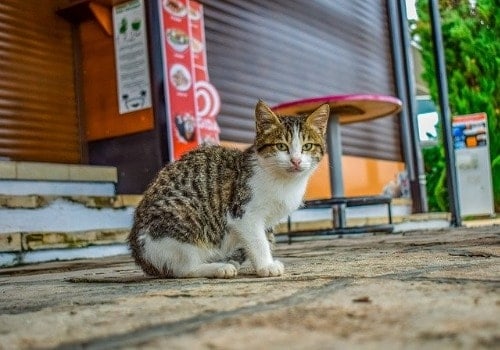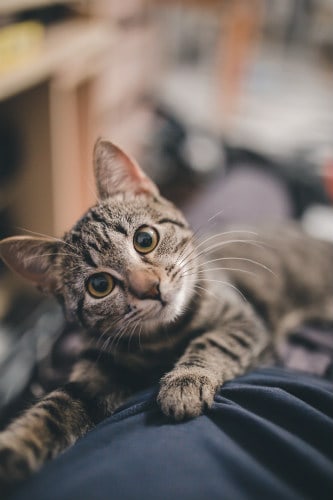Domestic cats are highly adaptable animals found in practically every environment and continent across the planet, showcasing their remarkable adaptability.
They’re often found in various settings too, including urban, suburban, and rural areas, where they coexist with humans as pets or live as feral in stray populations. They can survive in the hottest deserts and on the highest mountains.
Cats have been introduced to many regions by humans and have become naturalized in various environments, from temperate climates to tropical and even some arctic areas. However, they are not native to Australia (more on this later) and Antarctica (more on this later), and their presence in these locations is typically the result of human introduction or activity.
Domestic cats are found on every continent except for Antarctica and inhabit 118 of the 131 primary island groups worldwide.
Feral cats have been known to live in cities, forests, grasslands, farmland, tundra, wetlands, and scrublands. If a human can live in a specific environment, a domestic cat probably can also.
Cat Aren’t Native to Australia?
Cats aren’t native to Australia. They were introduced to the continent by European settlers in the 18th and 19th centuries, primarily to control rat and mouse populations.
Since then, domestic and feral cats have established populations across the country.
Feral cats in Australia have become a significant ecological concern, as they have a negative impact on native wildlife, particularly small mammals and birds. Conservation efforts are in place to manage feral cat populations and protect native species from predation.
How About Antarctica? Do Cats Live There?
Domestic cats are not naturally found in Antarctica, and they are not well-suited to survive the continent’s harsh conditions.
Antarctica’s extreme cold, lack of food sources, and strict conservation regulations make it an inhospitable environment for domestic cats.
Additionally, introducing cats to Antarctica could pose a threat to the fragile ecosystem and native wildlife, as they could become invasive predators if they were to establish a population there.
Where Did Domestic Cats Come From?

Domestic cats are believed to descend from the African wildcat (Felis lybica), which evolved to live in hot and dry climates. For generations, people believed that the ancient Egyptians had domesticated cats, as they were known to have had a cat cult that revolved around the goddess Bastet, who was often depicted as a woman with a cat’s head.
Archaeologists, however, found the skeleton of an African wildcat buried next to a human in the southern part of Cyprus. Both skeletons were dated to around 7500 BC, about 9500 years before the present day. This is the oldest known evidence of somebody having tamed a wildcat.
Cyprus has no indigenous mammalian wildlife, so the cat’s owner and his fellow villagers must have brought the cat and any other mammals over from the European continent.
Researchers hypothesize that cats were domesticated around the same time that humans developed agriculture. Rodents were attracted to the stored grain, and the cats were attracted to the growing rodent populations. Neolithic farmers took advantage of the situation and encouraged the cats to stay. They gradually tamed and domesticated cats.
Cats were probably first domesticated in the Middle East’s Fertile Crescent, and they spread as agricultural practices spread. The first known records of domestic cats in Greece, for example, date back to 1200 BC. The ancient Romans brought cats to Sardinia, Corsica, and Britain.
The African wildcat has several traits that may have preadapted it for domestication, such as small size, high intelligence, and playfulness. While it hunts alone, it is otherwise social. It also has a body language that humans can learn to read.
Despite its long domestication, the cat has not changed much in either anatomy or behavior. Unlike many other domesticated animals, a domestic cat can often survive in the wild.
Where Did Cats, in General, Come From?

The first known cats appeared 25 million years ago during the Oligocene epoch. The first cat genus was Proailurus which eventually gave rise to Pseudaelurus, which became the ancestor of all modern cat species, as well as the extinct saber-tooth cats. Scientists have found Pseudaelurus fossils in Asia, Europe, and North America.
Modern cats all belong to a single family called Felidae. It is divided into two subfamilies, Pantherinae and Felinae. Pantherinae contains two genera: Panthera (“big cats”) and Neofelis. Felinae encompasses the bulk of living felines and includes about a dozen extant genera and three extinct genera. One of those existing genera is Felis, which includes the domestic cat and several small wildcats like the African wildcat and the European wildcat.
The various species in the genus Felis are native to Africa, Europe, and parts of Asia. The domestic cat has been known to hybridize with the European wildcat (F. silvestris). Some cat breeders have crossed the domestic cat with the jungle cat (F. chaus) to produce a hybrid called the Chausie, which often looks like a very large Abyssinian.
What Is the Difference Between a Stray Cat and a Feral Cat?

Both stray cats and feral cats are domestic cats that don’t live with a human. A stray cat, however, is often a pet that has been lost or abandoned. It is used to humans and will not avoid them. There are a number of anecdotes on sites like Youtube about people being approached or “chosen” by stray cats, and the stories often end with the person taking the cat in.
Feral cats, by contrast, have never been socialized to accept humans. For all intents and purposes, they are wild animals and avoid people. They hunt and scavenge for their own food, and they have territories. Feral cats often live together in colonies, although they hunt alone.
One reason why cats become and stay feral is that the window for socialization is extremely small. The main period for socialization in kittens is between two and seven weeks of age, but it can last for as long as 14 weeks in some kittens.
A kitten is most receptive to new experiences and people during their socialization window. It is thus the time to introduce it to a variety of people and expose it to such experiences as car rides and trips to the vet so it will grow up into a confident and friendly cat.
Kittens taken from a feral mother can thus only be rehabilitated into pets if they are rescued at a very young age. Older kittens generally can’t be socialized any more easily than adult feral cats.
”I Got a Cat! What Does It Need?”
Basic supplies for taking care of a cat include the following:
- Cat food
- Food and water dishes
- Cat litter
- Litter box
- Scratching post
A cat will also need a comfortable place to sleep. Some people buy cat beds, while others share their bed with the cat.
Cats need medical care. At the least, it should be taken to the vet once a year for a routine check-up. Sick and injured cats should be taken to the vet to get the necessary treatment.
Cats should be microchipped. Indoor cats can escape and get lost, and a microchip greatly increases the chances of it being found. It is now standard procedure at many animal shelters and veterinarians to scan a lost cat’s microchip and use the resulting information to try to contact the owner.
Is It Okay to Let a Cat Go Outside?
Once upon a time, cats spent most of their time outdoors. People who tried to keep their cats inside filled cat boxes with things like sand, dirt, or sawdust. While the cats didn’t mind burying their waste in such materials, they did nothing to reduce the pungent smell of cat urine.
In 1947, Edward Lowe was a businessman who sold different materials used in machine shops and factories to absorb grease and oil. A client named Kay Draper asked Lowe for an alternative to the ashes she used in her cat box, for she was tired of her cat tracking ashes all though the house. Lowe sold her some granulated clay – and then promptly forgot about it.
Two weeks later, Draper bought more of the granulated clay, and many of her friends followed suit. Lowe soon dubbed the granulated clay “Kitty Litter” and advertised its absorbent and deodorizing properties. The last one was a particularly big selling point.
The advent of kitty litter thus made it possible to keep cats wholly indoors — and many people argue that cats should be kept inside.
The main advantage to letting a cat go outside is that the great outdoors provides a variety of stimulating sights, sounds, and smells. A cat can hunt and explore like its wild ancestors.
The main disadvantage is the various dangers. An outdoor cat can get hit by a car or killed by another animal. If it eats its kill after a hunt, it risks getting parasites – which means a trip to the vet for deworming. A cat may have more fun outside, but that fun comes with a hefty price tag, including a shortened life expectancy.
What Is a Catio?

A catio is a “cat patio” or outdoor enclosure designed to provide a cat with the fresh air and stimulation of the great outdoors while keeping it safe from such hazards as cars or unfriendly dogs. It also protects birds and other small animals from the cat.
There are many different types of catios, and they always have some sort of access to the house, so the cat may come and go as it pleases. In many cases, the cat can use a window or cat flap to enter and leave the catio. Some catios will have tunnels connecting them to the house.
The bigger catios can accommodate humans and their furniture, so the owner can join their feline friend. Catios also have ledges or perches, where the cat can sleep or watch birds outside.
What Is a Cat Café?
A cat café is what the name suggests: a café that keeps cats on the premises and lets patrons interact with them. The first cat café opened in 1998 in Taiwan and quickly became a tourist attraction. In 2005, the first Japanese cat café opened in Tokyo.
Many Japanese live in small apartments that do not allow pets, so they fell in love with cat cafés. Over the next five years, nearly 80 cat cafés opened across the country.
The first cat café in the US did not open until 2014, for health departments typically require the cats to be kept out of places where people are eating and drinking. Cat cafés in the United States often work with local animal shelters or rescue groups to help get the cats adopted out. They can provide shelter for as many as two dozen cats, and those cats get increased exposure to people that heightens their chances of getting adopted. Cat cafés choose cats based on their temperament and looks.
How Long Do Cats Live (Video)
"In ancient times cats were worshipped as gods; they have not forgotten this."
-- Terry Pratchett






I like the cat picture and thank you for giving me information about cats!!!!!!!
yep
This helped with research for my cat essay!
Where do cats live
a cat live in a cattery
Ay
Thank you very much. I hope people use this for assignments, like I am.
Do anyone knows what’s the author’s name? I’m using this to write my research report and I need to write the author’s name. Thanks for someone who can help me!
There’s an “About the Author” on every post — look for it. For this article it says “Charles Joseph.”
where does a felis catus live
hey
cute
Where do cats live? Like, around the globe?
Thanks for the information, mate.